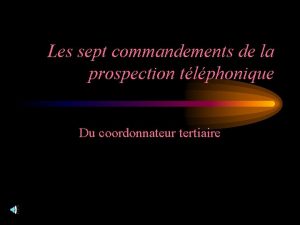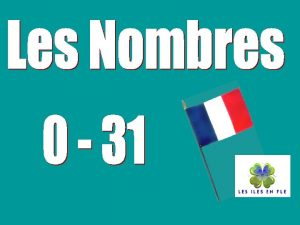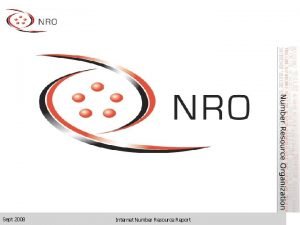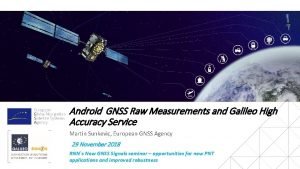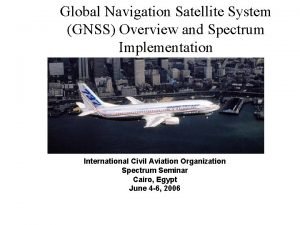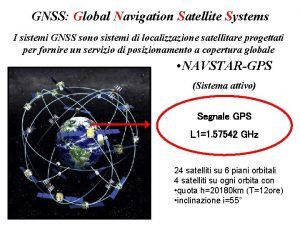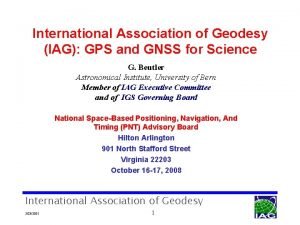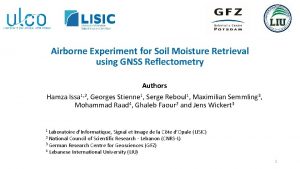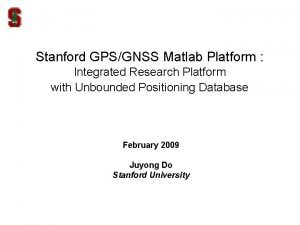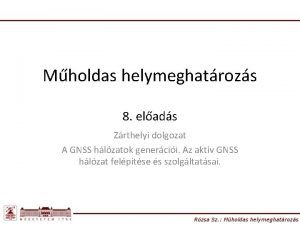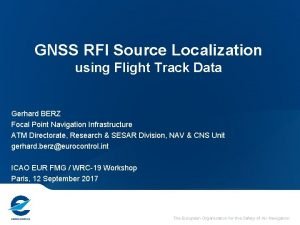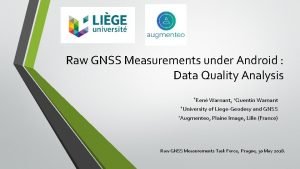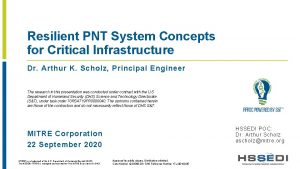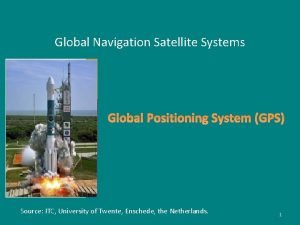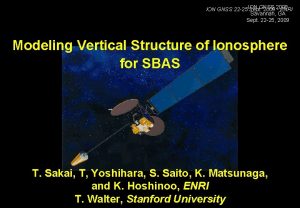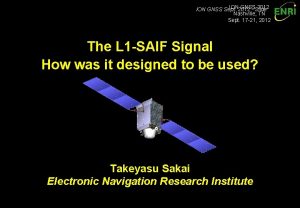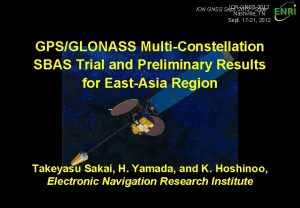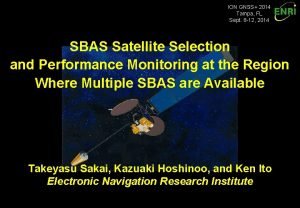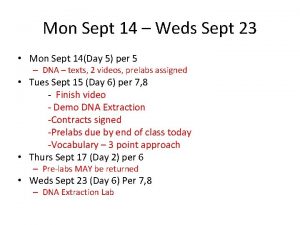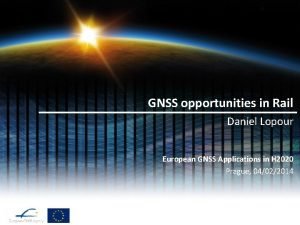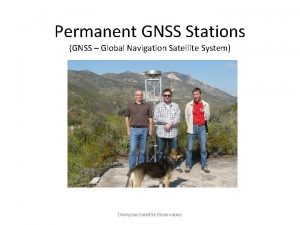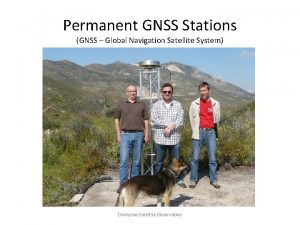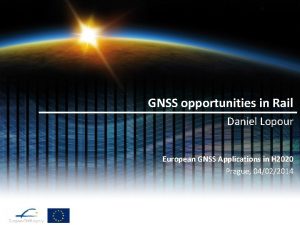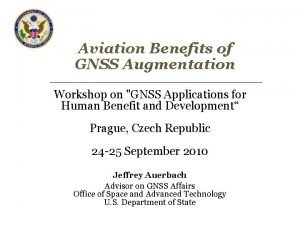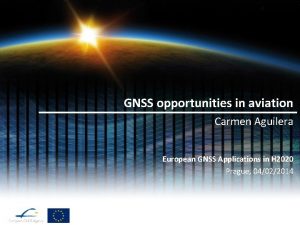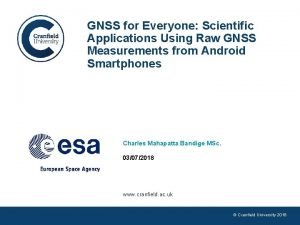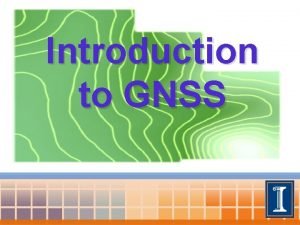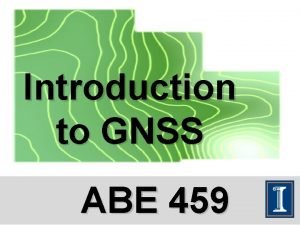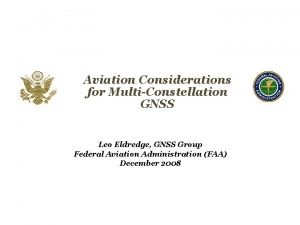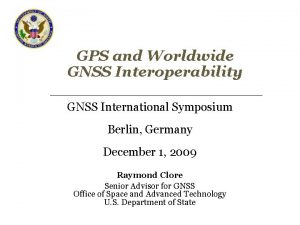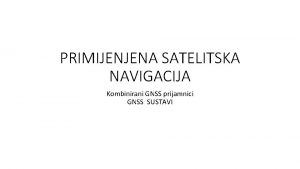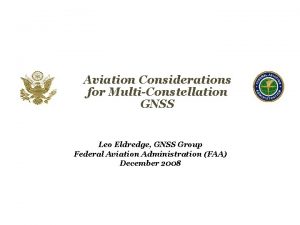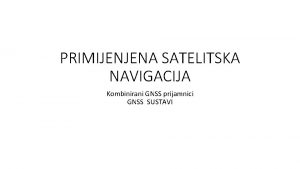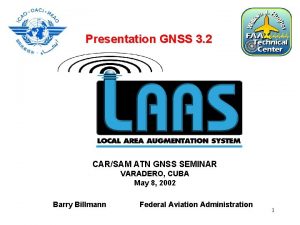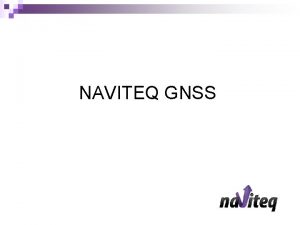ION GNSS 16 19 ION Sept GNSS 2008



























- Slides: 27

ION GNSS 16 -19 ION Sept. GNSS 2008 - ENRI Savannah, GA Sept. 16 -19, 2008 Modeling Ionospheric Spatial Threat Based on Dense Observation Datasets for MSAS T. Sakai, K. Matsunaga, K. Hoshinoo, ENRI T. Walter, Stanford University

ION GNSS 16 -19 Sept. 2008 - ENRI Introduction 1 • The ionospheric effect is a major error source for SBAS: – The ionospheric term is the dominant factor of protection levels; – Necessary to develop ionosphere algorithms reducing ionospheric component of protection levels to improve availability of vertical guidance. • Threat model should be prepared for new algorithms: – Any algorithms need the associate spatial threat model to ensure overbounding residual error; – The threat model depends upon the algorithms; – Developed a methodology to create a spatial threat model. • Threat models created by the proposed methodology: – Evaluation of the current MSAS threat model; – Some new threat models evaluated; System availability also evaluated.

ION GNSS 16 -19 Sept. 2008 - ENRI MSAS Status 2 • All facilities installed: – 2 GEOs: MTSAT-1 R (PRN 129) and MTSAT-2 (PRN 137) on orbit; – 4 domestic GMSs and 2 RMSs (Hawaii and Australia) connected with 2 MCSs; – IOC WAAS software with localization. • Successfully certified for aviation use. • IOC service since Sept. 27, 2007; – Certified for Enroute to NPA operations; – Approved for navigation use in Japanese FIR. Launch of MTSAT-1 R (Photo: RSC)

ION GNSS 16 -19 Sept. 2008 - ENRI 3 Position Accuracy GPS @Takayama (940058) 05/11/14 to 16 PRN 129 MSAS Horizontal RMS 0. 50 m MAX 4. 87 m GPS @Takayama (940058) 05/11/14 to 16 PRN 129 MSAS Vertical RMS 0. 73 m MAX 3. 70 m

ION GNSS 16 -19 Sept. 2008 - ENRI Concerns for MSAS 4 • The current MSAS is built on the IOC WAAS: – As the first satellite navigation system developed by Japan, the design tends to be conservative; – The primary purpose is providing horizontal navigation means to aviation users; Ionopsheric corrections may not be used; – Achieves 100% availability of Enroute to NPA flight modes. • The major concern for vertical guidance is ionosphere: – The ionospheric term is dominant factor of protection levels; – Necessary to reduce ionospheric term to provide vertical guidance with reasonable availability.

ION GNSS 16 -19 Sept. 2008 - ENRI 5 NPA Availability MSAS Broadcast 08/1/17 00: 00 -24: 00 PRN 129 (MTSAT-1 R) Operational Signal 100% Everywhere Contour plot for: NPA Availability HAL = 556 m VAL = N/A • 100% Availability for Enroute thru NPA.

ION GNSS 16 -19 Sept. 2008 - ENRI 6 APV-I Availability MSAS Broadcast 08/1/17 00: 00 -24: 00 PRN 129 (MTSAT-1 R) Operational Signal Contour plot for: APV-I Availability HAL = 40 m VAL = 50 m • Vertical guidance cannot be provided by the current MSAS.

ION GNSS 16 -19 Sept. 2008 - ENRI 7 Components of VPL Ionosphere (5. 33 s. UIRE) Clock & Orbit (5. 33 sflt) MSAS Broadcast 06/10/17 00: 00 -12: 00 3011 Tokyo PRN 129 (MTSAT-1 R) Test Signal • The ionospheric term (GIVE) is dominant component of Vertical Protection Level.

ION GNSS 16 -19 Sept. 2008 - ENRI Ionosphere Term: GIVE 8 • Ionospheric component: GIVE: – Uncertainty of estimated vertical ionospheric delay; – Broadcast as 4 -bit GIVEI index. • Current algorithm: ‘Planar Fit’: – Vertical delay is estimated as parameters of planar ionosphere model; – GIVE is computed based on the formal variance of the estimation. • The formal variance is inflated by: – Rirreg: Inflation factor based on chi-square statistics handling the worst case that the distribution of true residual errors is not well-sampled; a function of the number of IPPs; Rirreg = 2. 38 for 30 IPPs; – Undersampled threat model: Margin for threat the significant structure of ionosphere is not captured by IPP samples; a function of spatial distribution (weighted centroid) of available IPPs.

ION GNSS 16 -19 Sept. 2008 - ENRI 9 Planar Fit and GIVE • Developed for WAAS; MSAS employs the same algorithm; Vertical Delay Cutoff Radius IPP Fit Plane IGP • Assume ionospheric vertical delay can be modeled as a plane; • Model parameters are estimated by the least square fit; • GIVE (grid ionosphere vertical error): Uncertainty of the estimation including spatial and temporal threats. • GIVE Equation Formal Sigma Spatial Threat Model Spatial Threat Temporal Threat

ION GNSS 16 -19 Sept. 2008 - ENRI Ionospheric Spatial Threat IPP for fit User IPP IGP 10 • Planar fit is performed with IPPs (ionospheric pierce points) measured by GMS stations; • Local irregularities might not be sampled by any GMS stations; • Users might use IPPs within the local irregularities; Potential threat of large position error; • MSAS must protect users against such a condition; The spatial threat term is added to GIVE; Rfit Irregularity • Spatial threat model created based on the historical severe ionospheric storm data.

ION GNSS 16 -19 Sept. 2008 - ENRI Example of Spatial Threat Model Max Residual • • • 11 Threat Model Function of fit radius (cutoff radius) and RCM metric; Good and bad IPP geometries are distinguished by these two metrics; Resulted sundersampled is roughly between 0 and 2. 5.

ION GNSS 16 -19 Sept. 2008 - ENRI The Second Metric: RCM 12 • RCM (Relative Centroid Metric) is used as the second metric of the threat model; The first one is fit radius; IGP dcent Rfit Weighted centroid of IPPs • RCM is the distance between the weighted centroid of IPPs and IGP divided by fit radius; • Using Rfit and RCM, it is possible to distinguish good and bad geometries of IPP distribution, and thus reduce undersampled threat term; • For detail, see Ref. [11].

ION GNSS 16 -19 Sept. 2008 - ENRI Methodology: Data Deprivation 13 IGP R 1 • • • R 2 Rfit Threat Model Removes some IPPs (shown in red) for planar fit; They become virtual users; Residual: difference between estimated plane and removed IPPs (virtual users); Tabulates residuals within the threat region (5 -deg square) with respect to fit radius and RCM; The largest residual in each cell contributes to the threat model because it means the possible maximum residual users may experience; • MSAS employs annular (shown above) and three-quadrant deprivation (Ref. [10]).

ION GNSS 16 -19 Sept. 2008 - ENRI Problems 14 • Current methodology: – Data deprivation; Annular and three-quadrant deprivation schemes; – Problem A: Possibility that some irregularities are not sampled in the input datasets prepared from GMS data; Only 6 domestic for MSAS; – Problem B: Resulted threat model seems to be too much conservative. • Proposal 1 (Problem A): Oversampling: – Creates spatial threat model based on dense observation datasets; – Captures any irregularities even in severe storm conditions; – In Japan, GEONET is available source of such a dense observation. • Proposal 2 (Problem B): Alternative deprivation schemes: – Malicious deprivation and missing station deprivation schemes provide realistic conditions to be considered and avoid being over conservative.

ION GNSS 16 -19 Sept. 2008 - ENRI Datasets for Oversampling 15 • GEONET (GPS Earth Observation Network): – Operated by Geographical Survey Institute of Japan; – Near 1200 stations all over Japan; – 20 -30 km separation on average. • Prepared datasets: – Small/Large datasets are extracted from the complete datasets; – 6 -station datasets for simulating the current model; Domestic GMSs; – 210 -station datasets for oversampling. (Blue triangle) (Red circle) 6 -Station Datasets 210 -Station Datasets

ION GNSS 16 -19 Sept. 2008 - ENRI 16 Oversampling • Methodology: – Planar fit is performed based on measurements at MSAS GMSs; – All other measurements act as virtual users; Residuals from the estimated plane represent potential threats; – Threat region is sampled with a great density of measurements. • Storm Datasets: Set # Period Max Kp Remark 1 03 / 10 / 29 – 31 Storm 2 03 / 11 / 20 – 22 9 9 - 3 04 / 7 / 25 – 27 9 - Storm 4 04 / 11 / 8 – 10 9 - Strom 5 06 / 12 / 5 – 7 5 Solar Flare Storm

ION GNSS 16 -19 Sept. 2008 - ENRI Current Threat Model Max Residual 17 Threat Model (Current Model) • The threat model created by the same method as the current MSAS.

ION GNSS 16 -19 Sept. 2008 - ENRI Unsampled Threat: Safety Model 18 Detected Threat Max Residual Threat Model (Safety Model) • Oversampled by 210 stations; Created model: ‘Safety Model’ • Detected some irregularities not sampled by MSAS GMSs and not reflected to the current threat model.

ION GNSS 16 -19 Sept. 2008 - ENRI 19 Threat Detected by Oversampling View from MSAS GMS (6 -Station Set) Oversampling (210 -Station Set) • 6 -Station Set provided only one IPP within the threat region; • The threat was detected at the upper right corner of the threat region.

ION GNSS 16 -19 Sept. 2008 - ENRI Alternative Deprivation 20 • Malicious deprivation (Ref. [16]): – If storm detector trips, remove an IPP which has the largest residual from the plane; Repeat until storm detector does not trip; – Compute and tabulates residuals of removed IPPs; – The number of removed IPPs is limited up to 2 for this study. • Missing station deprivation (Ref. [11]): – Remove IPPs associate with a GMS; Repeat for every GMSs; – Remove IPPs associate with a satellite; Repeat for every satellites; – Compute and tabulates residuals of removed IPPs. • These schemes provide realistic conditions when creating a threat model.

ION GNSS 16 -19 Sept. 2008 - ENRI 21 Threat Model Metrics IGP dcent IGP MSA dmin Rfit RCM (Used by MSAS) • • IGP Rfit RMD MSA The candidate metrics as the second metric of threat models; Relative Centroid Metric(RCM):Distance to centroid divided by fit radius; Relative Minimum Distance(RMD):Distance to the nearest IPP divided by fit radius; Minimum Separation Angle(MSA):Maximum angle between adjacent IPPs divided by 360 degrees.

ION GNSS 16 -19 Sept. 2008 - ENRI 22 Threat Model (RCM) Threat Model (RCM Model) Performance • Malicious and missing station deprivation; Oversampled by 210 stations; • ‘Performance’: Relationship between data coverage and the associate overbounding sigma value.

ION GNSS 16 -19 Sept. 2008 - ENRI 23 Threat Model (RMD) Threat Model (RMD Model) • Tabulated with respect to RMD metric; • Sigma grows up quickly; RCM seems better metric. Performance

ION GNSS 16 -19 Sept. 2008 - ENRI 24 Threat Model (MSA) Threat Model (MSA Model) Performance • Tabulated with respect to MSA metric; • Sigma stays below 0. 7 m for half of trials; The best metric among three.

ION GNSS 16 -19 Sept. 2008 - ENRI 25 System Availability MSAS Availability for APV-I Flight Mode Safety Model MSA Model (Proposed) • Evaluated system availability with the proposed threat model of MSA metric; • Availability is improved from safety model; However not enough for service of vertical guidance flight modes.

ION GNSS 16 -19 Sept. 2008 - ENRI Conclusion 26 • Needs to develop a methodology to create threat model: – Investigating ionosphere algorithms to improve the performance of MSAS; – Any new algorithms need the associate spatial threat model. • Proposed methodology to create a threat model: – – – The current methodology: Data deprivation; Oversampling and alternative deprivation are proposed; Evaluated candidates of threat model metric; MSA metric works well with the proposed methodology. • Further investigations: – Investigate ionospheric algorithms and operational parameters which minimizes the associate threat model; – Consider other candidates of threat model metric; – Temporal variation and scintillation effects.
 2008 2008
2008 2008 Sept comme setteur questionnaire
Sept comme setteur questionnaire Sept commandements
Sept commandements Ectomy examples
Ectomy examples Cities built on seven hills
Cities built on seven hills Cnn 10 september 7th
Cnn 10 september 7th Zero un deux trois quatre cinq six sept huit neuf
Zero un deux trois quatre cinq six sept huit neuf Sept
Sept Les arbres des villes georges drouillat
Les arbres des villes georges drouillat Sept heure moins le quart
Sept heure moins le quart Deportes
Deportes I sept
I sept Ecrivez les sept jours de la semaine
Ecrivez les sept jours de la semaine Accu poole sept
Accu poole sept La guerre de sept ans
La guerre de sept ans Pnt
Pnt Gnss receiver
Gnss receiver Differenza tra gnss e gps
Differenza tra gnss e gps Sistemas de aumentacion gnss
Sistemas de aumentacion gnss Pnt gnss
Pnt gnss Trimble access site calibration
Trimble access site calibration Gnss
Gnss Matlab stanford
Matlab stanford Gnssnet
Gnssnet Pnt gnss
Pnt gnss Android force full gnss measurements
Android force full gnss measurements Resilient pnt
Resilient pnt Three segments that make up a gnss
Three segments that make up a gnss


